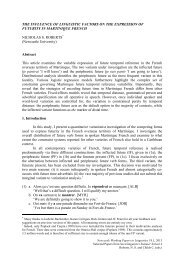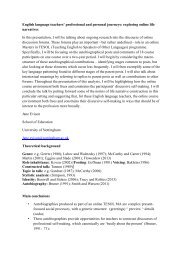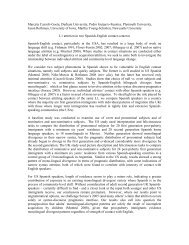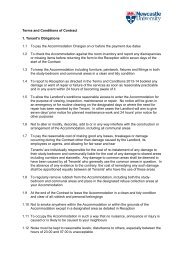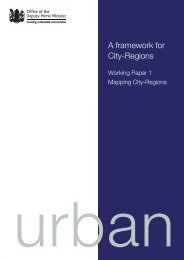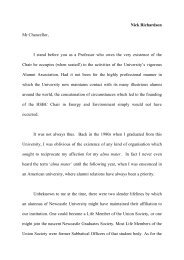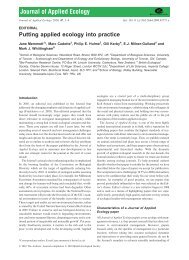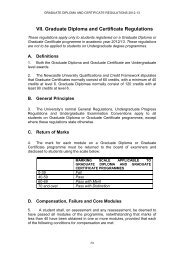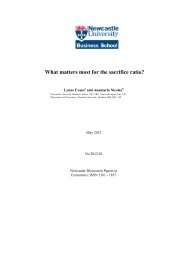156 STUDYING LOANWORDS AND LOANWORD INTEGRATION ...
156 STUDYING LOANWORDS AND LOANWORD INTEGRATION ...
156 STUDYING LOANWORDS AND LOANWORD INTEGRATION ...
You also want an ePaper? Increase the reach of your titles
YUMPU automatically turns print PDFs into web optimized ePapers that Google loves.
Winter-Froemel<br />
the grapheme in Fr. bifteck (PR, LAR, DHLF) can neither be explained by<br />
referring to the English form (containing ), nor can it be led back to an integration<br />
process yielding an integrated form (as is non-native with respect to the<br />
graphematic system of French). Certainly such substitutions are not very frequent, and<br />
in fact they are not mentioned in most traditional and current studies of loanwords.<br />
Nevertheless, recent studies show that they can be observed in a broad range of<br />
languages (e.g. Janda, Joseph & Jacobs 1994), which provides further evidence for the<br />
usefulness of distinguishing and combining the two criteria.<br />
1.3 The definition of Fremdwort and Lehnwort in the restricted sense<br />
In 1.3, I have left open the question of how Fremdwort and Lehnwort in the<br />
restricted sense should be defined. More precisely, I have left open the question whether<br />
one of the two criteria of conformity should be accorded priority, and if so, which.<br />
Reconsidering the different options given in Fig. 3 and the traditional use of the concept<br />
‘loanword integration’, I propose to regard conformity to the TL system as decisive.<br />
That is, Fremdwörter can be defined as words which fall either partially or fully into the<br />
category of transference. They keep at least one element of non-native structure in the<br />
borrowing process (e.g. word-final stress as in Germ. Büro [by'ro:]), while Lehnwörter<br />
in the restricted sense entirely conform to the TL system (e.g. Ital. tango).<br />
However, this does by no means imply that the criterion of conformity to the SL<br />
form is completely rejected. On the contrary, it seems possible to combine it with the<br />
other criterion and to introduce further subdivisions. Thereby we can distinguish nonintegrated<br />
Fremdwörter (e.g. Ital. brioche) vs. partially integrated Fremdwörter (e.g.<br />
Germ. Büro [by'ro:]) and Lehnwörter by correspondence (e.g. Ital. tango) vs.<br />
Lehnwörter by integration (e.g. Ital. brioscia).<br />
1.4 The diachronic development of borrowed words<br />
As illustrated in Fig. 3 above, the combination of the criteria permits us to<br />
capture the different processes that may occur during the situation of linguistic<br />
borrowing proper, when a TL speaker borrows a certain expression and uses it for the<br />
first time in the TL. In addition, I shall now argue that both criteria can also be applied<br />
to the further development of borrowed items in the TL, that is, to processes by which a<br />
borrowed item may be increasingly adapted to the structures of the TL (recall the<br />
example of Germ. Büro cited above in (10) as well as examples (5)-(8)). The following<br />
proposals to change borrowed words provide further examples (in the case of Queneau,<br />
with clearly humoristic intentions):<br />
(14) Fr. snobe (instead of snob, Etiemble 1964: 316)<br />
(15) Fr. tiquet (instead of ticket, Etiemble 1964: 316)<br />
(16) Fr. guidenappeur (instead of kidnapper, R. Queneau, Zazie: 108)<br />
(17) Fr. bloudjinnzes (instead of blue jeans, R. Queneau, Zazie: 48)<br />
As we enter a temporal dimension here, the two criteria of conformity are<br />
combined with a further, chronological aspect. This means that we obtain altogether<br />
three aspects that are relevant for loanword studies. They can be opposed as<br />
comparative (criterion of conformity to the SL form), synchronic-internal (criterion of<br />
166



